 |
| Waaait a minute.. I didn’t see any candy cane guns in the game. Talk about false advertising |
Puzzles and Solvability
There’s not a huge amount of variation on the puzzles in the game. There are some objects to pick up and use or give to other characters. These objects are always easy to spot, often sticking out of their surroundings.
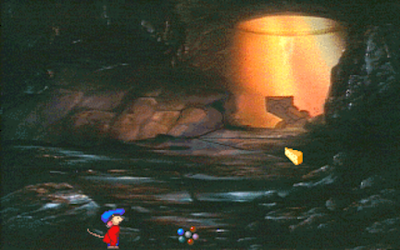 |
| No need to hunt for THESE pixels |
Some of the puzzles are a bit nonsensical if you haven’t watched the movies (more about that later). Like, why do you give the broccoli to Tiger the cat? If you’ve seen the movie, you might know that he’s a vegetarian, but there’s nothing in the game that gives you any kind of information about that. Then again, that doesn’t really make the puzzle very hard, since you don’t really have a lot of different items, and Fievel flat out asks him if he likes broccoli (provided you manage to pick the right dialogue option…)
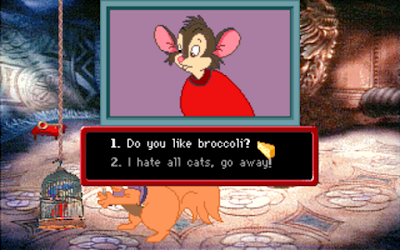 |
| I usually just like to talk about whatever’s in my pocket |
Finally there are the minigames. These are fun-ish, but most of them are quite easy. I struggled a little bit with the dots and boxes game, but it probably just felt like it lasted longer because the rest of the game was so brief. As I mentioned before, my total playtime was only 90 minutes, so the whole thing is clearly not a marathon. I guess you could theoretically get some extra mileage out of replaying the minigames, provided you plan out your saves.
Score: 4
Interface and Inventory
The game is obviously mouse-controlled (pun intended). The cursor is a piece of cheese, and you click stuff to interact with it. You can hover over exit points on each screen, to see where you can go.
If you click Fievel himself, you get the inventory.
 |
| This is probably the highest amount of items I had simultaneously |
 |
| Well, that lesson certainly didn’t stick |
 |
| The save slots are symbolized by items found in the game |
Score: 5
Story and Setting
It shouldn’t come as a surprise that the story and setting are based on the first two of the American tail movies. While this is fine in itself, I found it a bit annoying how much of the story isn’t really in the game. It’s like the developers picked out some sections of the movie, made a game out of them and just sort of glued them together with the help of a couple of filler screens, some minigames and a broccoli.
I have to presume that the game is made for those who know the movies, because storywise it doesn’t really work on its own. Sure, you get a fairly detailed introduction to each chapter, but after that, things just happen without any sort of proper build-up.
Settings wise, the game takes place first in turn-of-the-century New York and then in a western desert town, though all characters are animals. Not sure what more I can say about it.
Score: 2 ( Maybe 4 if you watch the movies first )
Sound and Graphics
For the most part, the graphics are decent. Since it’s a licensed game, they’ve clearly had the opportunity to use some images from the movies. The problem is that those images, while looking great on their own, haven’t always been properly merged with the rest of the game graphics. For instance, Fievel himself is always the same size, regardless of the scale of the background, sometimes with strange results.
 |
| Fievel and a rat that turns out to be a cat |
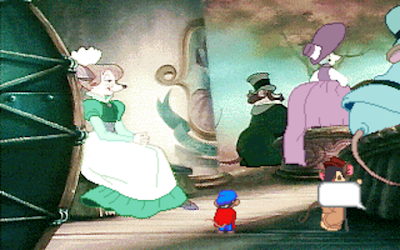 |
| Fievel and some other mice |
 |
| Movie screencap. Now with 200% more Fievel |
 |
| They could almost have gotten away with a palette swap, but why bother, right? |
 |
| Movie |
 |
| Looks good, but Fievel is almost the same height as that carriage wheel |
 |
| Fievel was the only one in his family to discover color protecting laundry detergents |
As for music, there’s just a single track that repeats over and over. It’s a jolly tune. That fits maybe a third of the locations in the game, though it plays through the whole thing. It’s not too annoying in short bursts, but if the game was longer, I would probably have turned it off at some point.
There are pretty much no sound effects, except during the shootout with the cats at the end. Actually I think the music stops too, during that sequence.
Score: 5
Environment and Atmosphere
The intro does a fair enough job of setting up the world and story. It’s just a shame that there’s so little of what follows. The game is almost too short to get any kind of atmosphere going. As I mentioned in the Story and setting category, it’s incoherent and doesn’t give you a lot of pretext for some of the things that are going on. Add to this that the protagonist’s sprite often sticks out quite a lot due to weird scales or colors not mixing in well with the background. In other words, there’s too much immersion breaking going on to really get into things.
Score: 3
Dialog and Acting
The dialogue is for the most part simplistic, but sort of gets the job done, if you disregard my previous point about needing to have seen the movies to make sense of everything.
 |
| As friends do |
 |
| Why are you leaving, anyway? |
 |
| Yeah, bite into those mouse burgers |
 |
| Dog logic is the best |
 |
| Yeah… so… yeah |
Total score: (4+5+2+5+3+3)/0.6 = 37 ( You can bump it up to 40 if you’ve seen the movies )This means that Leo Vellés’ guess was spot on. Congrats!
CAP Distribution
- Blogger Award - 100 CAPs - For playing and blogging about An American Tail
- Classic Blogger Award - 50 CAPs - For playing and blogging about The Paranoia
- Classic Blogger Award - 50 CAPs - For playing and blogging about La Secte Noire
- Pretentious Twat Award - 4 CAPs - For explaining the origin of the word "prat"
- Psychic Prediction Award - 10 CAPs - For the closest score guess for La Secte Noire
- Pun Master Award - 4 CAPs - For explaining a pun on Warren T.
- Christmas Hunter Award - 6 CAPs - For finding new Christmas games for Joe to play
- Psychic Prediction Award - 10 CAPs - For the closest score guess for An American Tail
- Paranoia Award - 6 CAPs - For finding a new Paranoia graphical adventure
- Movie Buff Award - 5 CAPs - For explaining details about An American Tail movies not clear in the game


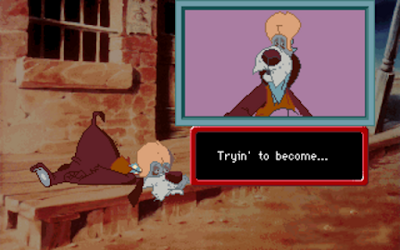
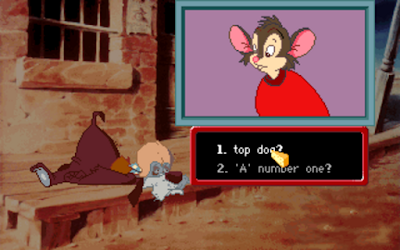





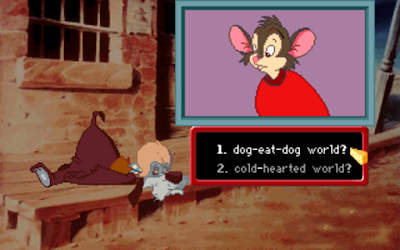
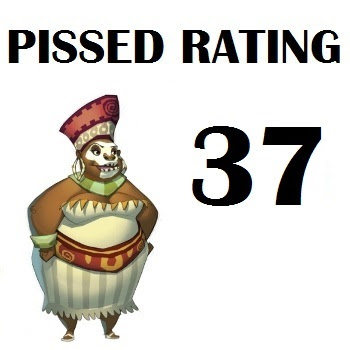
Capstone seems to be the kind of company to pick up licenses for cheap in the hopes that they could turn a profit, so that explains the delay between the movie and game. OTOH, the rest of their licensed titles are all more current with whatever they're licensed from.
ReplyDeleteHowever, I was checking Capstone's Wikipedia page, and apparently this may have been released in August 1992, which would put it slightly closer to the movie.
It is worth pointing out that this method didn't really work for them, since they went bankrupt in '96.
Hmm... according to Mobygames, it's 1993, so not sure about that wiki. The reference is to a Los Angeles Times article from august 1992, that you need a subscription to read. If anyone has access, it could be interesting to see what it says. Perhaps it's a game review, which could confirm a 1992 release date.
DeleteThe article says:
DeleteOnce again, Capstone delivers a promising new game that doesn't live up to its full promise.
"An American Tail: The Computer Adventures of Fievel and His Friends" is presented in two parts. Each part takes place separately and are based on Fievel's adventures in New York ("An American Tail") and out West ("An American Tail: Fievel Goes West"). The games are part adventure and part puzzle. Assorted puzzles include a matching game, scrambled-picture puzzles and a mock shooting gallery.
Our young testers were clamoring to try the game. They loved the movies and they wanted to love the game. They actually loved maneuvering around the screens and looking at the pictures. But the story was too hard for the 7-year-old to read, and the 9-year-old thought it was dumb.
Since it was too complicated for the younger kids to play alone, we thought we'd try it out as a "quality time" candidate. The problem is, the game is not of the quality to improve your time together. Although we ran into a couple of minor program bugs, they weren't game-stoppers. The game-stoppers were the puzzles that couldn't be solved by the target audience. Although there is no age range advertised on the game anywhere, we would assume it would include any kid old or young enough to be interested in the movie.
In addition, we have become used to a certain sophistication in the graphic animation quality of games. If you talk to a character and they walk off the screen to meet you at another location, you don't expect to turn around and find them in the same place next time you pass by. You expect to be able to control the speed of reading introductions or skipping them altogether.
This game had lots of promise and looks beautiful. But your kids will probably get more for your money by going back to see the movies again.
(This was followed by a star rating out of five, which was not preserved in the ProQuest database I'm looking at.)
Maybe some kind of pre-release review copy? Or maybe Mobygames is just wrong, or is generalizing from a release outside the US...?
There's a link to the article from the game's wiki page:
Deletehttps://www.latimes.com/archives/la-xpm-1992-08-29-ca-5439-story.html
(though its the same thing as what Lisa posted, just with the time and date. No, there's no star rating there, sloppy)
It does look like its from 1992, since there's a review from CGW and GamePro, later in 1992. Curious, what sources have we used in the past to detect when a game is from besides Mobygames?
We've done occasional dips to game magazines, but that's not 100 % reliable, since especially the lesser known games were reviewed often way after they were published (if ever).
DeleteAbandonia has the game as a 1993 release, and the game's wiki page says so too at the top, but then has multiple links to 1992 reviews. So it seems likely that it actually came out that year. Though it COULD be a case of US vs international release, as Lisa suggests. Anyway, thanks for posting the contents of the article!
DeleteOTOH, the rest of their licensed titles are all more current with whatever they're licensed from.
DeleteTheir Zorro game—an unplayably awful Prince of Persia knockoff—was released sometime around Summer 1995, or 2 1/2 years after the TV series it was based on had finished its run. But then I suppose Zorro is something of a perennial franchise, so timeliness doesn't matter as much.
Amusingly their Homey D. Clown game—ranked the fifth-worst of all time by Computer Gaming World—was released during In Living Color's fifth and final season, in which the character didn't feature at all because Damon Wayans had left the cast. Granted that's probably not the biggest reason the game was a terrible idea.
Does Abandonia generally do research on the year? Because in my experience abandonware websites either copy Mobygames or the copyright date.
Delete@Angry Internet
Ah, admittedly I must have overlooked those, I'm more focused on Capstone's FPS and adventure titles.
for a movie tie-in game for kids, it didn't seem too bad! Games based on movies in the 90s more often were platformers or action games, so it's nice to see an attempt at an adventure game.
ReplyDeleteIt's not that it's bad. It's just missing in a lot of departments. Seems rushed at times. Though I imagine kids who have watched the movies would be able to both enjoy it AND finish it, so that might count for something.
DeleteIt's like they tried to rush out a game to ride the film's hype, but missed the release by a few trifling years. Feels like the effort was minimal on the designer's part.
ReplyDeleteIndeed. They probably saved a ton of work by just digitizing the movie images for backgrounds. In that sense it would be strange if they missed a deadline by 2 years...
Delete